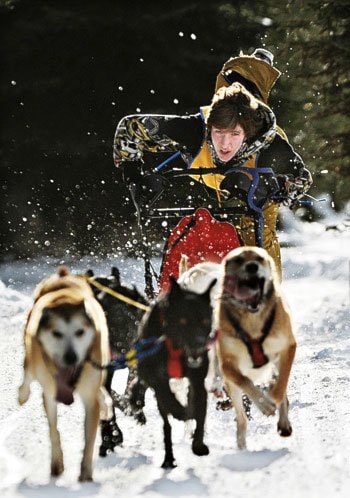With this year’s Yukon Quest starting in Whitehorse and ending in Fairbanks, some mushing buffs won’t get their fill of exciting sprints to the finish line.
Well, that might be the case, if not for this year’s River Runner 100.
The Road Runner 100, as it was known last year in its inaugural run, will not only start in Shipyards Park again, this year it will also end there, all amongst the thrill of Rendezvous weekend.
“Last year, everyone was under the impression that, running next to the road, it would be spectator friendly,” said organizing committee member Amil Dupui-Rossi. “I think the fact that it starts and finishes at Shipyards Park amidst Rendezvous makes it spectator friendly, even more so than having it run along the roadside in the wee hours of the morning.”
Last year’s 160-kilometre Road Runner, which finished in the Aishihik area, saw 17 mushing teams and three skijor teams enter.
This time the race, put on by the Dog Powered Sports Association of the Yukon, will be from Whitehorse to Mendenhall and back, using the Takhini River, the Dawson Overland Trail - like the Yukon Quest - cutting through the Ibex Valley.
The route means a lot less roadside mushing and more time on a river, hence the name change.
“One of the things about it going up along the highway is there’s lots of dips - ups and downs - and that wasn’t good for the skijorers,” said Dupui-Rossi. “The dogs faired well, but the skiers were all over the place.”
With a six-hour mandatory layover in Mendenhall, the dog-teams will leave Shipyards at 5 p.m. on February 26 and are expected to begin returning the next day around noon.
Stretching about 209 kilometres, the River Runner is far from the longest dog-sled race, but is the longest skijor race in North America - perhaps the world.
“I’m doing some research and I haven’t found anything to say otherwise,” said Dupui-Rossi.
Using the same trail going out as coming in, unlike last year, also helps insure proper grooming. Last year’s race was intended to finish in Haines Junction, but was cut short due to unexplained trail damage.
“Logistically, it’s a lot easier to put in and maintain a trail from Whitehorse to Mendenhall and back because we can get twice as much grooming on the trail,” said Darryl Sheepway, a committee member and a skijorer in last year’s race. “We can get twice as many trips on the trail and that will help ensure we have a better trail for the competitors this year, over last year.”
Crispin Studer, last year’s champion musher, and skijor winner Gaetan Pierrard, are expected to return to defend their titles. If they do register, that leaves space for 23 more teams, including skijorers.
Entry forms for the race, which costs $125 before the February 19 deadline, should be up on the association website at dpsay.wordpress.com by the weekend or early next week.
Sled dog teams require a minimum of six dogs with a maximum of 10 and skijor teams from two to four.
“It’s a challenge to train for. It’s quite a bit longer than any of the other skiing races - more than double,” said Sheepway.
“Completing it was a highlight for me, going that far and doing it in one big run.
“For training I’m just trying to put miles on the dogs, get them conditioned. So I’m starting to increase the mileage on my runs now.”
Contact Tom Patrick at tomp@yukon-news.com
